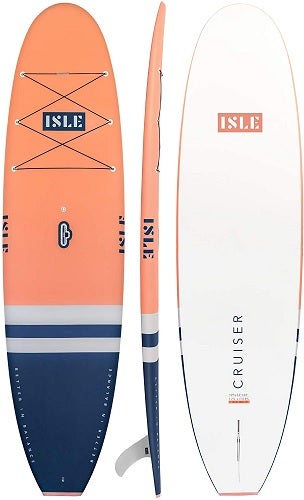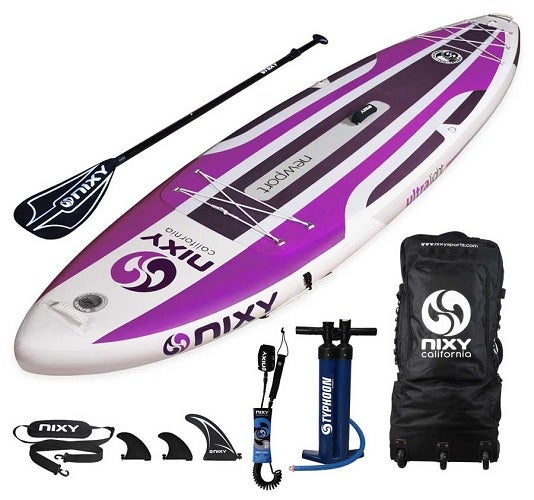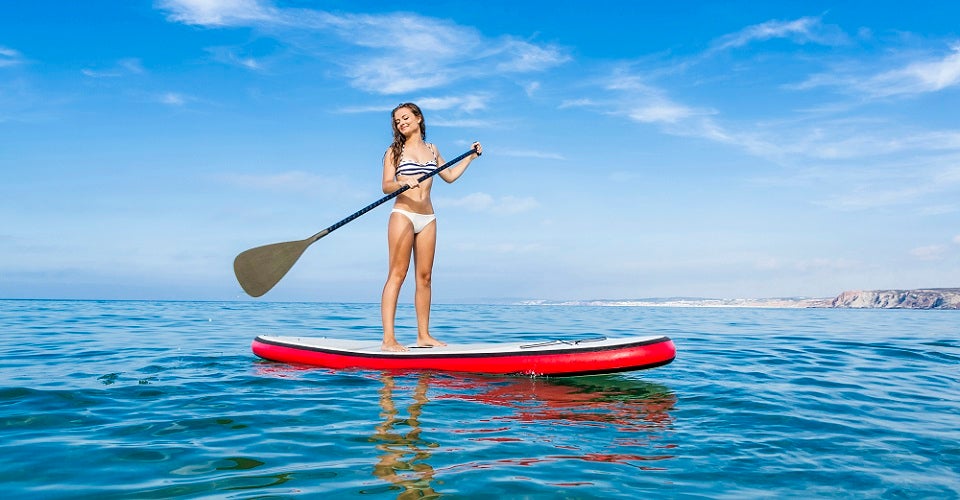
Our Editors independently research, test, and rate what we feel are the best products. We use affiliate links and may receive a small commission on purchases.
The sport of paddle boarding will allow you to explore the beauty of the ocean, rivers, and lakes with ease.
Paddle boarding is easy to learn and a lot of fun while giving you a good workout, so what are you waiting for?
So the only question is, what is the best all around paddle board to get out on the water with?
Well we have you covered! For all of our SUP recommendations, keep on scrolling.
Best All Around Paddle Boards
| Atoll Stand Up Paddle Board | ISLE Cruiser Stand Up Paddle | Roc All-Around iSUP Board | |
|---|---|---|---|
| Type: | Inflatable | Rigid | Inflatable |
| Length: | 11' | 10'5" | 10' |
| Width: | 32" | 32" | 32" |
| Max Weight: | 350 Pounds | 235 Pounds | 300 Pounds |
For more of my paddle board gear recommendations, have a look through these popular Outside Pursuits guide links: Life Jackets, SUP Paddles, Electric SUP Pumps.
Quick Answer: The 7 Best Rated All Around Paddle Boards
- Atoll Inflatable Stand Up Paddle Board
- ISLE Cruiser Stand Up Paddle
- Roc Inflatable Stand Up Paddle Board
- SereneLife Inflatable Stand Up Paddle Board
- Scott Burke Stand Up Paddleboard
- NIXY Newport ALL Around Inflatable Stand Up Paddle Board
- Peak Expedition Inflatable Stand Up Paddle Board
Our reviews of the top rated all around SUPs with a comparison table and our buyers guide below will help you choose the right SUP for you.
All Around Paddle Board Reviews
#1 Atoll Inflatable Stand Up Paddle Board
- Type of SUP: Inflatable
- Length: 11 feet
- Width: 32 inches
- Weight Capacity: 350 Pounds
- Extras: Nylon carry bag, 10’ leash, pump, removable 8″ fin
Consistently rated as one of the market’s top 10 stand up paddle boards, we knew we had to give this one a try. We always aim to make unbiased reviews, though, and we felt this one was easily one of the best.
It’s great for beginners and advanced paddlers alike, so no matter your skill level, give the Atoll a look. Coming in Blue, Burgundy, and Army Green, you have a few options when it comes to style.
The paddle board is 11 feet long, which is perfect for a single rider but you could probably fit two people. The 32-inch width is about average and provides good stability.
The ultra-light construction (40% lighter than comparable models) is made of dual layer PVC, which is durable and made to resist against rips and tears.
It comes with a high pressure dual action hand pump that isn’t as fast or user-friendly as an electric pump, but it still gets the job done quickly.
The EVA foam traction pad not only adds to the visuals of the board, but also work well to add comfort and grip. The durable nylon-webbed carrying handle is right at the middle of the board with a soft grip that made it comfortable to transport on land.
For keeping your gear secure, there are 15 D-rings and an oversized bungee cord storage net. 15 D-rings is more than double than some other models have, so needless to say you have a lot of options here.
With it’s combination of features and performance the Atoll is our Editor’s Choice as the best all around paddle board!
#2 ISLE Cruiser Stand Up Paddle
- Type of SUP: Rigid
- Length: 10’5″
- Width: 32″
- Weight Capacity: 235 Pounds
- Extras: 9” removable fin
The ISLE Cruiser is one of the better SUPs out there. The company decided to take their popular touring design and create a nice all around, recreational model.
Made with a foam core and dual stringers it’s extremely stable and perfect for choppy waters. The Cruiser has a fiberglass wrap around the core and with a thick EVA deck pad for a comfortable day on the water.
At 10 feet, 5 inches, it’s about average length. For beginners, this is a good length to start with and it’s easy to steer and maneuver.
The deck width is the same as the previous model, at 32 inches. This is also good for beginners, as it makes it stable and wide enough to hold any gear you may want to bring along for the ride.
Let’s go back to the soft top again because this is a very different SUP than most rigid epoxy models. It’s so comfy, in fact, that you could even bring your dog or a small child along if you’d like.
Keep in mind that the weight capacity on this model is 235 pounds, so make sure you aren’t exceeding that. If you are looking for the best all around SUP, the Cruiser is a good choice!
#3 Roc Inflatable Stand Up Paddle Board
- Type of SUP: Inflatable
- Length: 10 feet
- Width: 32 inches
- Weight Capacity: 300 Pounds
- Extras: Aluminum paddle, removable center fin, pump, carry backpack, leash and dry bag
The Roc Inflatable Stand Up Paddle Board caught our eye not only because of its unique colors and design, but also for how it works with people of all skill levels.
It’s not the widest, nor the longest, but it is quite stable and easy to maneuver for beginners.
Made of military-grade PVC with drop stitch technology, these are made to be practically indestructible, while still remaining very flexible and easy to roll up.
Video: First impression of the ROC Stand Up Inflatable Paddle Board.
When fully-inflated, the board is just as hard as rigid paddle boards, plus you can deflate and carry in the included backpack when you’re done!
The textured foam deck pad is made for comfort and added stability. The six front stainless steel D-rings have a bungee cord with them, so you can easily keep your gear secure, as well as your paddle.
They’ve included a lightweight aluminum paddle that’s adjusts to fit just about any height. The rear D-ring is great for using a leash or keeping it docked.
Even though it’s the most inexpensive SUP on our list, they even include a leash and a dry bag for storing valuables.
I would consider upgrading the paddle at some point, but the Roc is the best all around SUP for the money!
#4 SereneLife Inflatable Stand Up Paddle Board
- Type of SUP: Inflatable
- Length: 10.5 Feet
- Width: 32 inches
- Weight Capacity: 300 Pounds
- Extras: Carry backpack, pump, leash, paddle, phone pouch
The SereneLife All-Around Inflatable Stand Up Paddle Board is the best choice if you’re looking for an inexpensive SUP.
The inflatable board is 32” wide which makes it stable and still glides well. When fully-inflated it’s an extremely rigid board, comparable to standard epoxy SUPs.
The included paddle is made of aluminum, which is very lightweight and floats. The edges of the blade are made with a TVR rubber material that will hold up well against chipping.
For easy transport, it breaks down into 3 pieces when you’re all done and fits easily in the included carry backpack.
Also included is a hand pump with an integrated pressure gauge, a removable fin, leash and waterproof storage pouch for your phone.
With all of it features and quality, it’s easily one of the best all around iSUPs available!
#5 Scott Burke Stand Up Paddleboard
- Type of SUP: Rigid
- Length: 10 feet, 6 inches
- Width: 32 inches
- Weight Capacity: 75 Pounds
- Extras: Adjustable SUP Paddle
The Scott Burke is known for its strong construction, made of molded watertight EPS foam core which provides an exceptional amount of rigidity.
The durable outer polyethylene skin just adds to the durability. If you’re on the hunt for something that’s going to be able to handle more intense paddling adventures, this may be the SUP for you.
The keeled nose of this model makes tracking smooth, with a wonderful glide and an easy ride in both flat water and low surf.
The rear features a round thumb tail shape which helps with smooth rail transfers and pivots. The soft EVA foam wave-groove deck pad will provide you with great traction and comfort, so you won’t be slip-and-sliding around.
The bungee cord on the front of the board is perfect for stowing gear and the included paddle gets you out on the water as soon as it arrives at your house.
One of it’s best features is the thick deck pad that is extremely comfortable and provides a non slip grip that is perfect for all day paddling.
Transporting the Scott Burke is quite easy, with the unique ergo-grip carry handle located in the middle of the board. The location is convenient, and the grip is comfortable for carrying long distances.
Considering how inexpensive it is, we felt it was one of the best all around SUP boards!
#6 NIXY Newport All Around Inflatable Stand Up Paddle Board
- Type of SUP: Inflatable
- Length: 10 feet, 6 inches
- Width: 33 inches
- Weight Capacity: 300 Pounds
- Extras: Alloy paddle, wheeled carry bag, leash, pump, 3 fins
The NIXY SUP All Around Inflatable Stand Up Paddle Board was one of our favorites, with its affordable pricing, and high-quality construction.
The versatile SUP board comes with everything you need to get started: a wheeled backpack for easy transport, a pump, a lightweight 3-piece aluminum paddle, and a 10’ SUP leash. The wheeled backpack is a really nice touch when you transport it.
We liked the fact that the SUP came in various colors, so there’s something for everybody: Blue, Aqua, Purple, Pink, and Red.
The California-designed board is made using advanced Fusion Laminated Drop Stitch Technology to ensure long-lasting use.
In fact, it only weighs 20 pounds, so you can easily transport it and maneuver it in the water. To be honest, we didn’t find it to be as quick as some of the others on our list, but it’s not really made for that anyway.
Video: First paddle with the NIXY Newport Inflatable Paddle Board
The 8 stainless steel D-rings let you attach various accessories, and let you secure your gear or a seat if you’d like.
There are also 4 rings in the front, that are used in conjunction with a bungee cord so you can keep your extra equipment safe.
With a 300 pound weight limit that can be exceeded, you can take two people or maybe take your furry friend for a paddle! We found the NIXY to be one of the best all around inflatable SUPs!
#7 Peak Expedition Inflatable Stand Up Paddle Board
- Type of SUP: Inflatable
- Length: 10’6″ & 11′
- Width: 32 inches
- Weight Capacity: 275 Pounds
- Extras: Alloy paddle, carry backpack, inflation pump, 10 ft ankle leash, nylon center fin, waterproof smartphone case
The Peak Expedition Inflatable SUP is perfect for recreational paddlers, in all types of conditions. Be it rivers, oceans, lakes, and streams, they are all fair game. If you’d like, you can even bring an extra person or dog along for the ride!
As one of the most durable SUPs, you get a puncture-resistant outer shell that won’t get scratched or dinged up. This is one of the major advantages of inflatable SUPs!
The when fully inflated it’s rigidity makes it a great choice for choppier waters and added stability. The soft cushion deck pad will make sure you’re riding comfy and if you fall on it you will certainly appreciate it!
Being an inflatable model, we were pretty surprised at how lightweight this one was. It only weighs a mere 18 pounds – several pounds lighter than most other SUPs.
This makes it easy to paddle with, but also to transport. To add to the portability aspect, they have carry handles in the front, rear and center.
Another important note, is that this package includes everything you need. First, they give you an 3-piece alloy paddle with a nylon blade that floats if you drop it.
You’ll also receive a carry backpack, inflation pump, 10 ft. coiled ankle leash, a nylon center fin, and a waterproof smartphone case that matches the board!
All Around Paddle Boards Comparison Table
| Paddle Board | Type | Length | Width | Max Weight | Rating | |
|---|---|---|---|---|---|---|
| Atoll Inflatable SUP Board | Inflatable | 11 feet | 32" | 350 lbs | 4.9 / 5.0 | |
| Peak Navigator Rigid Epoxy Paddle Board | Rigid | 10.5 feet | 32" | 245 lbs | 4.5 / 5.0 | |
| Roc Inflatable Stand Up Paddle Board | Inflatable | 10 feet | 32" | 300 lbs | 4.8 / 5.0 | |
| Scott Burke Stand Up Paddleboard | Rigid | 10.5 feet | 32" | 275 lbs | 4.3 / 5.0 | |
| NIXY ALL Around iSUP | Inflatable | 10.5 feet | 33" | 300 lbs | 4.9 / 5.0 | |
| Peak Escape Soft Top Aqua | Inflatable | 10.5 feet | 32" | 275 lbs | 4.7 / 5.0 | |
| SereneLife Inflatable Stand Up Paddle Board | Inflatable | 10.5 feet | 32" | 300 lbs | 4.9 / 5.0 |
How to Choose the Best All Around Paddle Board – Buying Guide
- Paddle Board Size
- Inflatable vs. Rigid Paddle Boards
- Weight Capacity
- Soft Top or Not?
- Paddle Board Materials
- Design Considerations For SUPs
- Misc Considerations For Paddle Boards
- FAQs About Paddle Boards
- Tips For Paddle Boarding
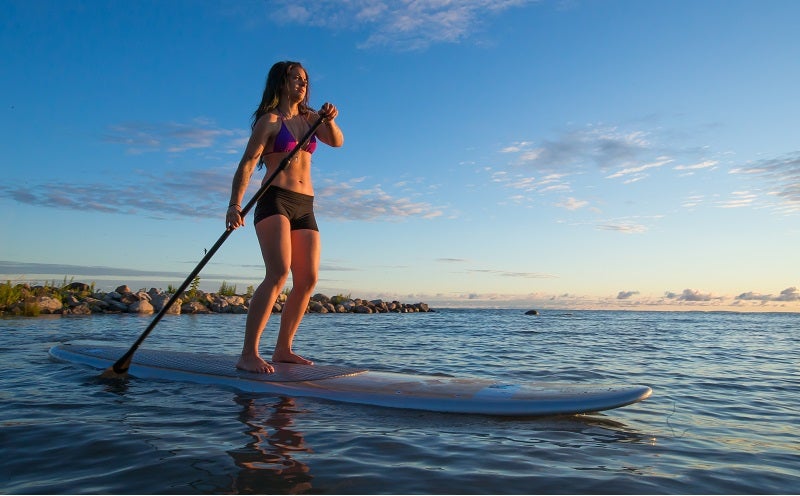
Paddle boarding is such a fun experience that you can enjoy by yourself or with others. However, for maximum fun, you’ll want to make sure you’re getting the best all around SUP board for your needs. That’s why we’ve gone ahead and created the following buying guide. It will help you choose a SUP with confidence.
Paddle Board Size
The first thing you’ll probably want to take a look at, are the measurements of the paddle board you’re considering. While it’s not an absolute rule, oftentimes, the size has a direct correlation with the weight capacity. If you need a larger weight capacity, you’ll probably want to go for a board that’s longer and wider.
Length
As a general rule of thumb, a longer board is faster and will track better, meaning it’s easier to keep the SUP in a straight line. The downside being they are less maneuverable and harder to turn.
While a longer board has its advantages, longer is not always better. When starting out, you’ll probably want a board that’s a bit shorter.
The reason why, is because shorter boards can be easier to control. It’s not a bad idea to start on a shorter model to hone your skills as a beginner and improve your comfort level.
In addition, shorter boards are going to be easier to transport! Of course, if you’re opting for an inflatable model this won’t matter quite as much, but if you want a rigid one, then take this into consideration.
Width
A wider board is great you’re starting out, as it will be more stable and easier for you to learn how to keep your balance. Paddle boarding is just like any other sport, and requires practice. However, you can make the learning curve a bit easier on yourself by starting out with a more stable platform to learn on.
Thickness
This is more of a factor with inflatable paddle boards. Since they are not made of a rigid epoxy and must be inflated. As a general rule, the thicker the board the more rigid it will be. A more rigid board is going to be more stable and easier to paddle. All the boards on our list are 6″ thick so they are plenty stiff when fully inflated.
Inflatable vs. Rigid Paddle Boards
That brings us to our next point. Will an inflatable paddleboard or a rigid model be right for you? There are pluses and minuses to each, so let’s take a quick look!
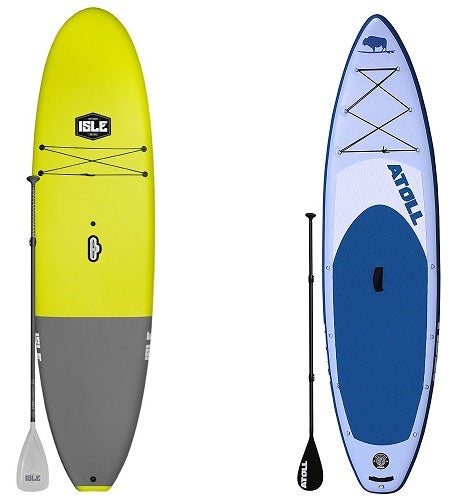
Inflatable SUPs
Inflatable boards are a good choice, no matter what skill set you have. They’re convenient, lightweight, and easy to maneuver. They come with hand pumps that you use to inflate it to the proper pressure. All the iSUPs on our list come with a pump that stores in the backpack.
When properly filled, these are just about as hard as rigid models. So you can feel confident taking them out even in rougher water.
They are easy to deflate and pack away when you’re all done for the day. You do have a small chance of them getting rips or tears, but as they’re made of such high-quality materials, this is most likely not going to be an issue.
With the reduced weight, you have a SUP that’s easier to maneuver on the water and carry back and forth to your car.
Rigid SUPs
We only had a few of the rigid types on our list, but there are some notable benefits to this type. They are more stable, with a lower center of gravity and being made from a foam core with an epoxy resin coating they will be more rigid than any inflatable.
You also don’t have to worry about filling it with air and deflating each time you want to go paddling. This means you can spend more time on the water, rather than prepping.
Solid boards are also often (not a rule) more affordable than inflatables but they also do not usually include a paddle and carry bag like all of the inflatables on our list.
The downside, of course being that they’re more of a hassle to transport. You will probably want to use a roof rack to transport them safely. I would also recommend a board bag to keep them safe when you are not using it or transporting it.
Weight Capacity
Obviously this is a huge factor in selecting the right board for you. Before anything else, you need to know how much weight you’re going to be placing on your new board.
Will you be paddling on your own? Even if you think you will be, it’s a good idea to get a higher weight capacity. In the future you may decide to bring someone else (human or dog) along with you.
Also think about the weight of the gear you’ll be attaching to your board. Will you be taking a cooler along? We recommend taking minimal equipment – just what’s necessary.
Soft Top or Not?
A few of the top SUPs out there are soft tops. These are very similar to epoxy boards, but they are wrapped in a soft EVA shell with an ABS bottom.
These are generally going to be the most affordable boards out there, and are also a good option if you’re going to be taking along children or a dog.
While the top may be soft and spongy, the core is super strong and rigid while remaining quite lightweight.
Paddle Board Materials
As we briefly mentioned above, there are differences in the materials used in inflatable and rigid boards.
Inflatable
These are typically going to be military-grade, double-layer nylon or high-quality PVC that makes sure your board doesn’t crack or bend but can still collapse easily and fold away for easy storage and transport. These are also nice if you’re planning on paddling on vacation, or traveling.
Rigid Epoxy
These vary a bit more, but are typically just going to be made of a foam blend or a hard plastic where it does not collapse or give in any way. These are more catered towards beginners or those who require added stability. You may also see wood and fiberglass used in more expensive models.
Design Considerations For SUPs
Rocker
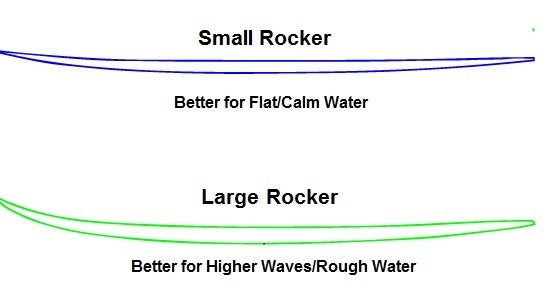 Rocker on a paddle board is how the nose of the board is angled up. As you can see from the above image the more the nose is angled up the better it is in rough water. If you plan on paddle boarding in flat calm water, like lakes and rivers, a small nose rocker is better
Rocker on a paddle board is how the nose of the board is angled up. As you can see from the above image the more the nose is angled up the better it is in rough water. If you plan on paddle boarding in flat calm water, like lakes and rivers, a small nose rocker is better
If on the other hand you will be paddle boarding in the ocean or bays where waves are more common, a larger rocker is a better fit. If you plan on using the board for surfing a larger nose rocker is also desirable.
Deck Pad
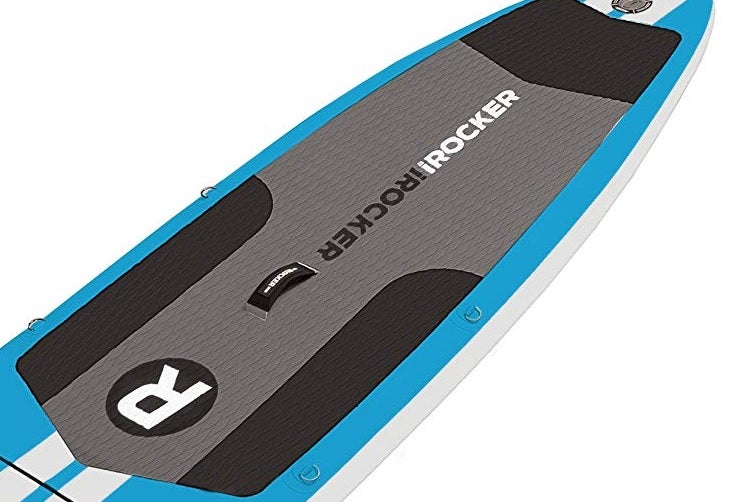
The padding on the board is an important consideration. The thicker the pad the more comfortable it will be. If you plan on touring or all day paddling, make sure the deck padding is made from a thick EVA foam like on the Atoll SUP.
If you think you will have other riders along or maybe your dog, take a look at how much of the board is padded. All SUPs are not equal in this regard! The NIXY is ideal as most of the board has a good slip resistant deck pad.
Fins
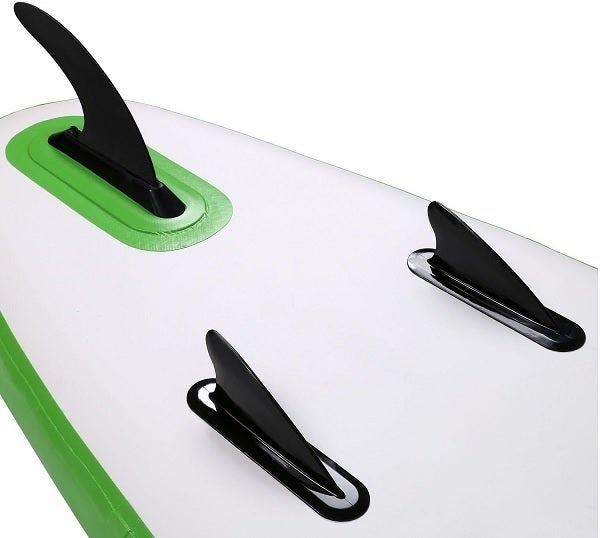
The fins on the bottom of the SUP are what helps “tracking” or the ability to keep the paddle board in a straight line. A SUP that doesn’t track will tend to turn with each stroke of the paddle.
Inflatable SUPs are usually of the “tri-fin” design as you can see in the image above. The layout is a larger center fin of roughly 5″- 6″ with two smaller side fins. Better paddle boards will have the ability to remove all the fins so it rolls up better.
Most rigid epoxy SUPs typically come with one larger center fin that is removable. Since rigid SUPs tend to track better they usually only have the one center fin.
Rails
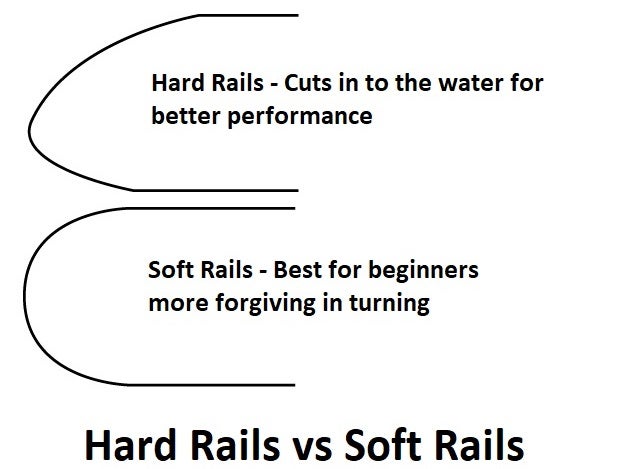
The rails of a SUP will determine its “bite” or how well they turn in the water when on edge. This is primarily a consideration if you plan on using the board to surf. Surf boards tend to have “hard rails” where paddle boards have “soft rails” that are suitable for general use paddling.
Misc Considerations For Paddle Boards
Stability
As we have previously discussed, stability is one the primary considerations for choosing a SUP. Stability is defined by how easy it is to stay balanced on the board or how “tippy” it is. The width of the board is one of the main determinants on how stable the board is. The wider the board the more stable it is!
As a general rule, rigid SUPs will be more stable than iSUPs because they sit lower in the water with a lower center of gravity.
The last factor in the stability of the paddle board is how rigid it is. This is why recommend you inflate your paddle board to at least 15 PSI, assuming it is an inflatable model. Rigid SUPs win out in this regard as they are always going to be more rigid than an inflatable model.
Performance While Paddling
Here we are referring to “glide” or how well the SUP cuts through the water while paddling. By their nature of being thicker and not quite as stiff as a rigid epoxy SUP they will be somewhat slower and not cut through the water as well.
One other factor in how well it glides through the water is the “rocker” of the board. A higher rocker allows the board to glide through the water better than a lower rocker. This is especially noticeable in rougher water.
Ease of Transport
In considering how easy it is to transport your SUP, an inflatable will win most every time. It is one of the primary reasons to buy an iSUP, they can be rolled up and put in the back of your car or hatch.
With iSUPs the backpack that they come with is a big factor. In this regard the NIXY is the clear winner with its 3 wheeled backpack. This makes it very easy to transport over pavement because you can pull it behind you like a suitcase.
Other iSUPs you will need to put on your back and carry it. Rigid SUPs will need to be transported on a roof rack if you don’t have a pickup truck so you can put in the bed.
Speed/Ease of Inflation
Obviously this is only a factor with an iSUP and is determined by the volume of the SUP and the pump you are using. In this regard the iRocker is the clear winner with its triple action pump that has a high volume setting to get the SUP filled, then a high pressure setting that makes it incredibly easier to pump to higher pressure.
If you plan on using your iSUP a lot, I would HIGHLY recommend an electric pump that plugs into your car accessory outlet or connected to an 12V battery.
FAQs About Paddle Boards
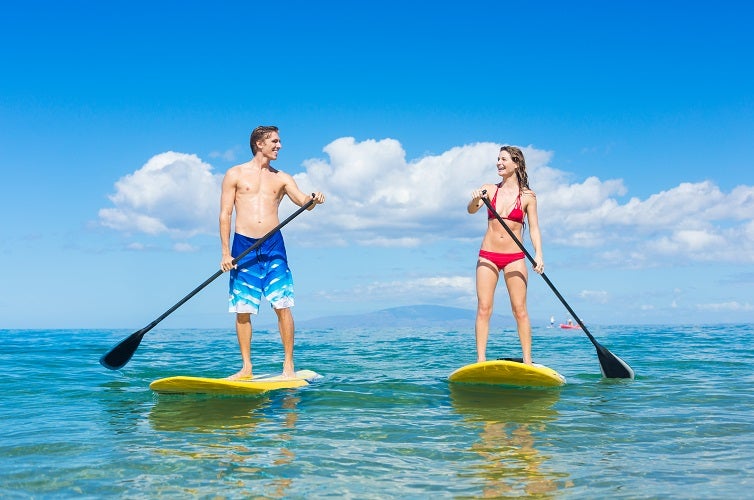
Q: What kind of paddle is right for me?
So often we talk about the right paddle boards, but the right paddle is just as important to having a great experience. You’ll want to select one that’s lightweight and comfortable in your hands. Try to get one which is about 6 to 10 inches longer than your height.
An easy way to do this is to get an adjustable paddle so you don’t have to guess, and can use it between various riders. Also, it’s extremely important to get a floating paddle! You don’t want it to sink to the bottom if you accidentally drop it.
Q: How should I get on my new paddle board?
This can be a bit tricky at first, but don’t worry; it gets easier with practice! First, walk your board into water around knee-deep. Place the paddle by the nose so it’s perpendicular to the long side. Then, put one knee on, where the handle is.
Once you’ve got that down, hold on and pull up the other knee so you are completely knelt into a position you feel stable in. Stay there for a second, then place your hands on the board with your paddle under your palms.
Slowly (really emphasizing the “slowly” part) move into a low crouch, and simultaneously bring your paddle up. Then, keep straightening your back with the knees slightly bent, and you’re all set!
Here is a video showing the basics on how to get started paddle boarding:
Q: How should I stand on my SUP?
This isn’t going to be like surfing or skateboarding where you have one foot in front of the other. Rather, you’ll have both feet facing straight ahead, shoulder-width apart.
A crucial part here, is to keep the knees a bit bent at all times to absorb any choppy water and avoid it knocking you off your balance.
Q; What’s the best stroke to use?
As the paddle you use will most likely have a little bend at the blade, it may feel a bit unnatural to use. Just hold it with the bend facing the back of the board. Make sure you’re moving it with your core strength, rather than your arms.
Place one arm on the handle and one on the shaft, so you have a kind of triangle shape going on. Bring the paddle ahead, then twist as it goes into the water. Then pull it back towards your feet, and repeat the process. Your arms should be straight until the stroke is complete.
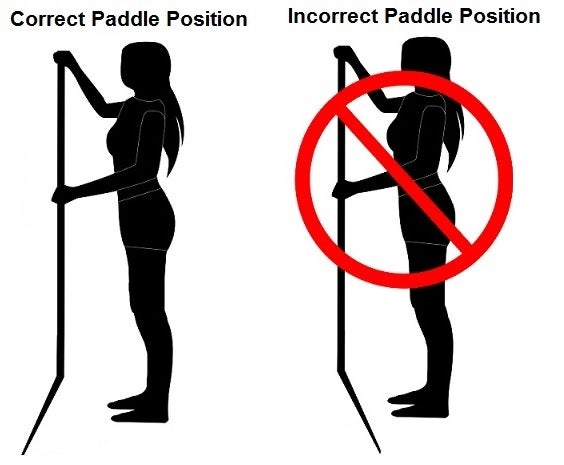
Q: Will I really need my leash?
It’s definitely a good idea. The leash keeps the board from getting away from you if you fall in. This is especially important if you are in a current.
Q: What shall I do if I fall?
Falling is pretty much inevitable when you’re first starting out. You may only do it a couple of times, but knowing how to proceed will help make it easier.
When you fall, try to jump away from your board. Once you start coming up, shield you arms with your head in case your board is above you when you start to surface. Always try to keep away from rocks and any hard surfaces. Paddle on your knees when you’re in shallow water and keep your distance from other paddlers.
Tips For Paddle Boarding
#1: Make sure your paddle is facing the right way
This is a common mistake. Make sure the paddle turn is facing the rear of the board. You don’t want it to be scooping the water, even though this may feel more natural.
#2: Focus on the horizon
When we start out, it’s tempting to just look down at the board or the water surrounding it. To make sure you’re the most stable, make sure to keep your head up and facing forward, watching out over the horizon.
#3: Only ride waves you can handle
Perhaps you may find that the weather changes quickly at times, and the water may start to get choppier. If you can’t handle this, then make sure you’re heading back to water you are comfortable with. Remember, the water is more powerful than us and we must respect it.
#4: Keep an eye on the wind
This kind of ties in with our last point, but always know what conditions your paddling out to before you begin. Take a look at the forecast and the tide so you’re properly prepared. When standing on your SUP, you’re basically like a sail. If it gets super windy, lay down with the paddle under you and paddle like you would a surfboard.
Final Thoughts
Getting a SUP is an exciting experience, and the act of paddle boarding is not only great for your health, but great for the mind and for sharing with friends and family. We hope that our guide has helped you find the best all around paddle board for you. Thanks for tuning in, and we’ll see you again soon!
How We Researched
To come up with the top paddle boards, we researched a variety of sources for reviews such as REI, Dicks Sporting Goods, West Marine and Backcountry along with our own personal experience.
We also consulted online magazines for product research and reviews to get as much unbiased information as we could. To help weed out fake reviews we used Fakespot.com to make sure we only looked at genuine reviews.
With so much quality gear available, we had to narrow it down based on what we felt were the best options were for the price. The author, Richard Remick has been an avid paddle boarder for over 10 years.
To help narrow down the selection he used his personal experience along with recommendations from paddle board instructors, and rental shops.
After extensive research, we came up with our list to help you choose the right one for you.
Sources

